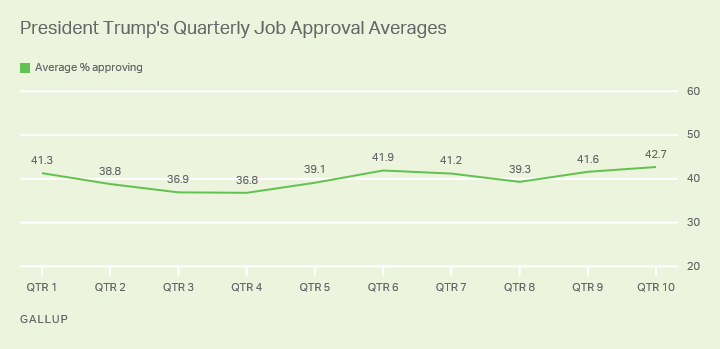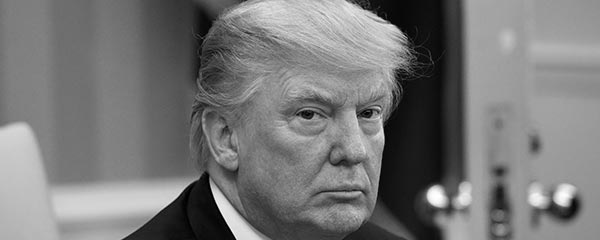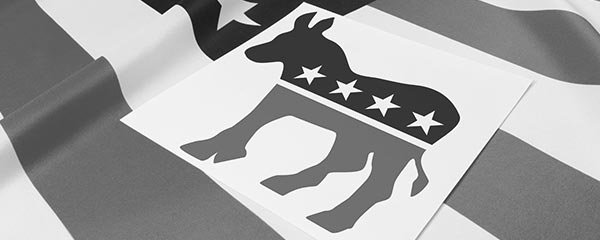Story Highlights
- Highest quarterly average to date for Trump
- Less than three percentage points above his term average of 40%
- Has 44% job approval rating in the latest Gallup poll
WASHINGTON, D.C. -- During President Donald Trump's 10th quarter in office, from mid-April through mid-July, an average of 42.7% of Americans approved of the job he was doing as president. The latest average is his best to date, edging out the 41.9% he received during his sixth quarter in office. However, his quarterly averages have not varied much throughout his presidency, all registering within a narrow six-point range of 36.8% to 42.7%.

Trump began his tenth quarter with a 46% job approval average, the highest he has gotten in any single poll. Strong economic news and the initial findings from Robert Mueller's report on the Russia investigation were two likely factors in Trump's higher ratings.
But by the end of May, his approval rating had fallen back to 40%, as more details about the Mueller findings emerged and Trump prepared to impose new tariffs on Chinese products.
His latest job approval rating, from a July 1-12 survey, is 44%. That poll was conducted before the recent controversy over Trump's remarks about four Democratic House members who are women of color, which led to the House passing a resolution (largely along party lines) that condemned Trump's use of racist language.
Although Trump's 42.7% 10th quarter average is his best so far, it remains low in an absolute sense. Of 295 presidential quarters for which Gallup has data, back to 1945, it ranks 228th, or in the bottom 22% of all quarters.
Carter Had Worse 10th Quarter Average Than Trump
Trump's 10th quarter average also is low in comparison with other presidents' averages at the same stage of their presidency, but is not the lowest. Jimmy Carter had a lower average job approval rating during his 10th quarter in office, 30.7%. At that time, in the late spring and early summer of 1979, the U.S. dealt with a nationwide energy crisis and soaring gas prices.
Among the 10 post-World War II presidents elected to their first term, four had approval ratings above the majority level, including Dwight Eisenhower, John Kennedy, George H.W. Bush and George W. Bush.
Trump's job approval rating is most similar to that of Ronald Reagan in the spring and early summer of 1983. Reagan's 44.4% average approval rating came at a time of double-digit unemployment rates in the U.S.
| Dates | Average approval rating | Number of polls | |||||||||||||||||||||||||||||||||||||||||||||||||||||||||||||||||||||||||||||||||||||||||||||||||
|---|---|---|---|---|---|---|---|---|---|---|---|---|---|---|---|---|---|---|---|---|---|---|---|---|---|---|---|---|---|---|---|---|---|---|---|---|---|---|---|---|---|---|---|---|---|---|---|---|---|---|---|---|---|---|---|---|---|---|---|---|---|---|---|---|---|---|---|---|---|---|---|---|---|---|---|---|---|---|---|---|---|---|---|---|---|---|---|---|---|---|---|---|---|---|---|---|---|---|---|
| Eisenhower | 1955 Apr 20-Jul 19 | 69.3 | 4 | ||||||||||||||||||||||||||||||||||||||||||||||||||||||||||||||||||||||||||||||||||||||||||||||||
| Kennedy | 1963 Apr 29-Jul 19 | 67.7 | 3 | ||||||||||||||||||||||||||||||||||||||||||||||||||||||||||||||||||||||||||||||||||||||||||||||||
| Nixon | 1971 Apr 29-Jul 19 | 49.2 | 5 | ||||||||||||||||||||||||||||||||||||||||||||||||||||||||||||||||||||||||||||||||||||||||||||||||
| Carter | 1979 Apr 20-Jul 19 | 30.7 | 6 | ||||||||||||||||||||||||||||||||||||||||||||||||||||||||||||||||||||||||||||||||||||||||||||||||
| Reagan | 1983 Apr 20-Jul 19 | 44.4 | 5 | ||||||||||||||||||||||||||||||||||||||||||||||||||||||||||||||||||||||||||||||||||||||||||||||||
| G.H.W. Bush | 1991 Apr 20-Jul 19 | 73.6 | 9 | ||||||||||||||||||||||||||||||||||||||||||||||||||||||||||||||||||||||||||||||||||||||||||||||||
| Clinton | 1995 Apr 20-Jul 19 | 49.3 | 4 | ||||||||||||||||||||||||||||||||||||||||||||||||||||||||||||||||||||||||||||||||||||||||||||||||
| G.W. Bush | 2003 Apr 20-Jul 19 | 64.0 | 9 | ||||||||||||||||||||||||||||||||||||||||||||||||||||||||||||||||||||||||||||||||||||||||||||||||
| Obama | 2011 Apr 20-Jul 19 | 46.8 | 88 | ||||||||||||||||||||||||||||||||||||||||||||||||||||||||||||||||||||||||||||||||||||||||||||||||
| Trump | 2019 Apr 20-Jul 19 | 42.7 | 6 | ||||||||||||||||||||||||||||||||||||||||||||||||||||||||||||||||||||||||||||||||||||||||||||||||
| Gallup | |||||||||||||||||||||||||||||||||||||||||||||||||||||||||||||||||||||||||||||||||||||||||||||||||||
Bottom Line
The fact that Trump's best quarterly job approval average to date is less than three full percentage points above his term average of 40%, and less than six points above his personal low, speaks to how stable his job ratings have been. This stability is mainly a reflection of the high degree of party polarization in his approval ratings -- an average of 90% of Republicans and 8% of Democrats approved of Trump during the most recent quarter. With barely one in three independents (35%) approving of the president, his re-election prospects appear weak at the present moment.
Presidents Reagan and Barack Obama came back from roughly similar approval ratings to win re-election; however, both came into office during poor economic times and were operating with unemployment rates at or near double digits during their third years in office. Unemployment declined between Reagan's and Obama's third and fourth years in office, and as it did, their approval ratings increased, eventually surpassing 50%.
In contrast, Trump took office when the economy was generally healthy. He can point to improvements under his watch, most notably the recent 50-year low in unemployment, as well as solid economic growth and record stock values. Americans are likely already taking the good economy into account when evaluating Trump. With limited opportunity for further economic gains in the next year, it would appear Trump's fourth-year approval ratings are unlikely to show the same improvement due to economic progress that Reagan's and Obama's did.
To date, George W. Bush had the lowest job approval rating for an incumbent president who won a second term -- 48% at the time of the election. Over the next 16 months, Trump would presumably need to get to that low-water mark in order to have a reasonable chance of winning a second term.
Explore President Trump's approval ratings and compare them with those of past presidents in the Gallup Presidential Job Approval Center.
View complete question responses and trends.
Learn more about how the Gallup Poll Social Series works.




